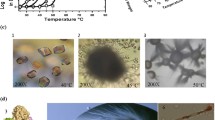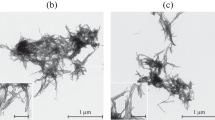Abstract
The effect of 16 amino acids (AA) with various physicochemical properties was investigated on human lysozyme (HL) heat-induced amorphous aggregation. UV-Visible spectrophotometry was used to monitor the kinetics of aggregation in the absence and presence of AA, and transmission electron microscopy (TEM) images were taken from the aggregates. To conduct in silico experiments, Autodock vina was used for docking of AA into protein (via YASARA interface), and FTmap information was checked for an insight onto putative binding sites. Prediction of aggregation-prone regions of lysozyme was made by AGGRESCAN and Tango. Among all tested AA, phenylalanine had the best anti-aggregation effect, followed by lysine. In addition, based on in silico tests, Trp 109 and Val 110 of lysozyme are suggested to be of importance in the aggregation process of the enzyme. In conclusion, phenylalanine, arginine, and lysine were found to affect the nucleation phase of lysozyme aggregation and could be considered as suitable stabilizing structures for this enzyme.





Similar content being viewed by others
References
Al-Hussein, A., & Gieseler, H. (2013). Investigation of histidine stabilizing effects on LDH during freeze-drying. Journal of Pharmaceutical Sciences, 102(3), 813–826.
Alavi, P., Yousefi, R., Amirghofran, S., Karbalaei-Heidari, H. R., & Moosavi-Movahedi, A. A. (2013). Structural analysis and aggregation propensity of reduced and nonreduced glycated insulin adducts. Applied Biochemistry and Biotechnology, 170(3), 623–638.
Arakawa, T., Tsumoto, K., Kita, Y., Chang, B., & Ejima, D. (2007). Biotechnology applications of amino acids in protein purification and formulations. Amino Acids, 33(4), 587–605.
Behbahani, M., Nosrati, M., & Mohabatkar, H. (2018). Inhibition of human immunodeficiency type 1 virus (HIV-1) life cycle by different egg white lysozymes. Applied Biochemistry and Biotechnology, 185(3), 786–798.
Conchillo-Solé, O., de Groot, N. S., Avilés, F. X., Vendrell, J., Daura, X., & Ventura, S. (2007). AGGRESCAN: a server for the prediction and evaluation of “hot spots” of aggregation in polypeptides. BMC Bioinformatics, 8(1), 65.
Hamada, H., Arakawa, T., & Shiraki, K. (2009). Effect of additives on protein aggregation. Current Pharmaceutical Biotechnology, 10(4), 400–407.
Hong, T., Iwashita, K., Handa, A., & Shiraki, K. (2017). Arginine prevents thermal aggregation of hen egg white proteins. Food Research International, 97, 272–279.
Huang, P., Shi, J., Sun, Q., Dong, X., & Zhang, N. (2018). Engineering Pichia pastoris for efficient production of a novel bifunctional Strongylocentrotus purpuratus invertebrate-type lysozyme. Applied Biochemistry and Biotechnology, 186(2), 459–475.
Humphrey, B. D., Huang, N., & Klasing, K. C. (2002). Rice expressing lactoferrin and lysozyme has antibiotic-like properties when fed to chicks. The Journal of Nutrition, 132(6), 1214–1218.
Kozakov, D., Grove, L. E., Hall, D. R., Bohnuud, T., Mottarella, S. E., Luo, L., Xia, B., Beglov, D., & Vajda, S. (2015). The FTMap family of web servers for determining and characterizing ligand-binding hot spots of proteins. Nature Protocols, 10(5), 733–755.
Krieger, E., & Vriend, G. (2014). YASARA view—molecular graphics for all devices—from smartphones to workstations. Bioinformatics, 30(20), 2981–2982.
Lee-Huang, S., Huang, P. L., Sun, Y., Huang, P. L., Kung, H.-f., Blithe, D. L., & Chen, H.-C. (1999). Lysozyme and RNases as anti-HIV components in β-core preparations of human chorionic gonadotropin. Proceedings of the National Academy of Sciences, 96(6), 2678–2681.
Meng-Lund, H., Friis, N., van de Weert, M., Rantanen, J., Poso, A., Grohganz, H., & Jorgensen, L. (2017). Correlation between calculated molecular descriptors of excipient amino acids and experimentally observed thermal stability of lysozyme. International Journal of Pharmaceutics, 523(1), 238–245.
Moghadam, T. T., & Ranjbar, B. (2015). Heat induced aggregation of gold nanorods for rapid visual detection of lysozyme. Talanta, 144, 778–787.
Paik, S. H., Kim, Y. J., Han, S. K., Kim, J. M., Huh, J. W., & Park, Y. I. (2012). Mixture of three amino acids as stabilizers replacing albumin in lyophilization of new third generation recombinant factor VIII GreenGene F. Biotechnology Progress, 28(6), 1517–1525.
Pepys, M., Hawkins, P., Booth, D., Vigushin, D., Tennent, G., Soutar, A., Totty, N., Nguyen, O., Blake, C., & Terry, C. (1993). Human lysozyme gene mutations cause hereditary systemic amyloidosis. Nature, 362(6420), 553–557.
Qureshi, H. Y., Li, T., MacDonald, R., Cho, C. M., Leclerc, N., & Paudel, H. K. (2013). Interaction of 14-3-3ζ with microtubule-associated protein tau within alzheimer’s disease neurofibrillary tangles. Biochemistry, 52(37), 6445–6455.
Shiraki, K., Kudou, M., Fujiwara, S., Imanaka, T., & Takagi, M. (2002). Biophysical effect of amino acids on the prevention of protein aggregation. The Journal of Biochemistry, 132(4), 591–595.
Tomita, S., Yoshikawa, H., & Shiraki, K. (2011). Arginine controls heat-induced cluster–cluster aggregation of lysozyme at around the isoelectric point. Biopolymers, 95(10), 695–701.
Trott, O., & Olson, A. J. (2010). AutoDock Vina: improving the speed and accuracy of docking with a new scoring function, efficient optimization, and multithreading. Journal of Computational Chemistry, 31(2), 455–461.
Tsolis, A. C., Papandreou, N. C., Iconomidou, V. A., & Hamodrakas, S. J. (2013). A consensus method for the prediction of ‘aggregation-prone’peptides in globular proteins. PLoS One, 8(1), e54175.
Vázquez-Rey, M., & Lang, D. A. (2011). Aggregates in monoclonal antibody manufacturing processes. Biotechnology and Bioengineering, 108(7), 1494–1508.
Vetri, V., Canale, C., Relini, A., Librizzi, F., Militello, V., Gliozzi, A., & Leone, M. (2007). Amyloid fibrils formation and amorphous aggregation in concanavalin A. Biophysical Chemistry, 125(1), 184–190.
Author information
Authors and Affiliations
Corresponding authors
Ethics declarations
Conflict of Interest
The authors declare that they have no conflict of interest. Experiments were done in vitro with purchased recombinant enzyme.
Ethical Approval
This article does not contain any studies with human participants or animals performed by any of the authors.
Additional information
Publisher’s Note
Springer Nature remains neutral with regard to jurisdictional claims in published maps and institutional affiliations.
Electronic Supplementary Material
ESM 1
(DOCX 653 kb)
Rights and permissions
About this article
Cite this article
Saadati-Eskandari, N., Navidpour, L., Yaghmaei, P. et al. Amino Acids as Additives against Amorphous Aggregation: In Vitro and In Silico Study on Human Lysozyme. Appl Biochem Biotechnol 189, 305–317 (2019). https://doi.org/10.1007/s12010-019-03010-4
Received:
Accepted:
Published:
Issue Date:
DOI: https://doi.org/10.1007/s12010-019-03010-4




